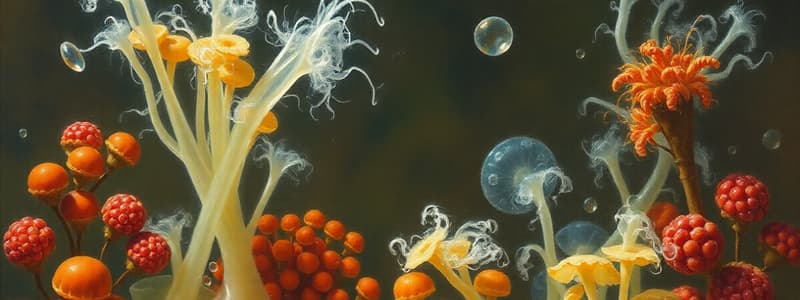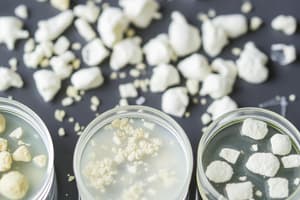Podcast
Questions and Answers
Which of the following is NOT a selective medium?
Which of the following is NOT a selective medium?
- SS agar
- Nutrient agar (correct)
- Mannitol salt agar
- MacConkey agar
Differential media allow the growth of specific microorganisms while inhibiting others.
Differential media allow the growth of specific microorganisms while inhibiting others.
False (B)
What is the primary function of a transport medium?
What is the primary function of a transport medium?
To maintain the viability of potential pathogens during transportation to a laboratory for testing.
The ______ agar is both selective and differential, inhibiting the growth of gram-positive bacteria and differentiating between lactose fermenters and non-fermenters.
The ______ agar is both selective and differential, inhibiting the growth of gram-positive bacteria and differentiating between lactose fermenters and non-fermenters.
Match the following media types with their primary function:
Match the following media types with their primary function:
Which of the following is a characteristic of an anaerobic medium?
Which of the following is a characteristic of an anaerobic medium?
What is the purpose of an assay medium in microbiology?
What is the purpose of an assay medium in microbiology?
A lab report should include a title, introduction, materials and methods, results, and conclusion.
A lab report should include a title, introduction, materials and methods, results, and conclusion.
What is the purpose of using agar in solid media?
What is the purpose of using agar in solid media?
Synthetic media consists of ingredients that are not chemically defined.
Synthetic media consists of ingredients that are not chemically defined.
Give an example of an enriched media.
Give an example of an enriched media.
The __________ is used for demonstrating bacterial motility.
The __________ is used for demonstrating bacterial motility.
Match the following types of culture media with their descriptions:
Match the following types of culture media with their descriptions:
Which component is NOT typically found in culture media?
Which component is NOT typically found in culture media?
Liquid media, also referred to as broth, contains at least 0.5% agar.
Liquid media, also referred to as broth, contains at least 0.5% agar.
What is the classification of culture media based on their purpose?
What is the classification of culture media based on their purpose?
What should not be introduced in the conclusion section of a lab report?
What should not be introduced in the conclusion section of a lab report?
Banned sources for references include journal articles.
Banned sources for references include journal articles.
What style should be used for referencing in a lab report?
What style should be used for referencing in a lab report?
The discussion section should explain trends arising from each table and provide comparisons with __________ studies.
The discussion section should explain trends arising from each table and provide comparisons with __________ studies.
Match the citation style with the source type:
Match the citation style with the source type:
How many references are warranted for each lab report?
How many references are warranted for each lab report?
Sources should be listed in random order in the references section.
Sources should be listed in random order in the references section.
For two authors, the correct citation format is __________ (Year of publication).
For two authors, the correct citation format is __________ (Year of publication).
Flashcards
Enrichment Medium
Enrichment Medium
A medium that boosts growth of certain organisms while limiting others.
Differential Medium
Differential Medium
A medium that allows differentiation of microorganisms based on visible changes.
Selective Medium
Selective Medium
A medium that impediments growth of some organisms using inhibitors.
MacConkey Agar
MacConkey Agar
Signup and view all the flashcards
Mannitol Salt Agar
Mannitol Salt Agar
Signup and view all the flashcards
Transport Media
Transport Media
Signup and view all the flashcards
Anaerobic Media
Anaerobic Media
Signup and view all the flashcards
Assay Medium
Assay Medium
Signup and view all the flashcards
Discussion in Lab Report
Discussion in Lab Report
Signup and view all the flashcards
Conclusion in Lab Report
Conclusion in Lab Report
Signup and view all the flashcards
APA Referencing Style
APA Referencing Style
Signup and view all the flashcards
Citing one author
Citing one author
Signup and view all the flashcards
Citing two authors
Citing two authors
Signup and view all the flashcards
Citing more than two authors
Citing more than two authors
Signup and view all the flashcards
Types of sources in references
Types of sources in references
Signup and view all the flashcards
Minimum references
Minimum references
Signup and view all the flashcards
Microbial Culture Media
Microbial Culture Media
Signup and view all the flashcards
Solid Medium
Solid Medium
Signup and view all the flashcards
Semi-Solid Medium
Semi-Solid Medium
Signup and view all the flashcards
Liquid Medium
Liquid Medium
Signup and view all the flashcards
Non-Synthetic Media
Non-Synthetic Media
Signup and view all the flashcards
Synthetic Media
Synthetic Media
Signup and view all the flashcards
General Purpose Media
General Purpose Media
Signup and view all the flashcards
Enriched Media
Enriched Media
Signup and view all the flashcards
Study Notes
Microbial Culture Media
- Used to grow microorganisms
- Come in various forms (plates, tubes)
- Differ in composition and characteristics.
Composition of Culture Medium
- Nutrients: Essential for growth
- Energy source: Provides energy for metabolic processes.
- Essential metals and minerals: Required for enzyme function and structural components.
- Buffering agents: Maintain a stable pH.
- Indicators for pH change: Show changes in pH.
- Selective agents: Favor the growth of certain microorganisms while inhibiting others.
- Gelling agent: Solidifies the medium.
Classification of Culture Media
Based on Physical State
- Solid medium: Contains agar for solidification.
- Agar is obtained from seaweed (e.g., Sphaerococcus euchema, Gelidium corneum).
- Agar is solid until boiling point
- Dissolves at boiling point
- Solidifies again below 40-42°C
- Agar percentage is 1.5 - 2% of total weight.
- Semi-solid medium: Lower agar concentration (0.5%). Soft consistency. Used to study bacterial motility.
- Liquid medium: No agar. Also called broth. Bacteria grow uniformly.
Based on Nutritional Factors
- Non-synthetic media: Contains undefined ingredients (e.g., beef extract, yeast extract).
- Synthetic media: Contains precisely defined chemical compounds.
- Defined medium: Contains specific quantities of known chemical components. (e.g., glucose, inorganic salts.)
Based on Function
-
General purpose media: Supports growth of various microorganisms.
-
Enriched media: Contains extra nutrients to support the growth of fastidious microorganisms (e.g., blood agar, chocolate agar).
-
Enrichment medium: Encourages the growth of specific microorganisms while inhibiting others. (e.g., lactose broth for enteric bacteria).
-
Differential medium: Allows differentiation of microorganisms based on visible changes in the medium (e.g. MacConkey agar).
-
Selective medium: Inhibits the growth of certain microorganisms while allowing others to grow (e.g., Mannitol salt agar).
- Some media are both differential and selective (e.g., MacConkey, EMB, Hektoen enteric).
-
Transport media: Maintains viability of microorganisms collected from clinical samples. Used for transportation (e.g., Pike's media, Sach's buffered glycerol saline).
-
Anaerobic media: Provides an environment of limited oxygen for anaerobic bacterial growth.
-
Assay media: Used for microbiological assays (e.g., amino acids, vitamins, antibiotics).
Lab Report Writing
Title
- Briefly describe the experiment.
Introduction
- Aim and background of the experiment including theory and method.
Materials and Methods
- Detailed description of the methods and materials. Include precautions and diagrams (especially non-standard equipment).
Results
- Display data in tables or graphs.
- Describe the results in words.
- Show calculations.
- Paragraph format, not bullet points.
- Do not list materials.
Discussion
- Analyze experimental trends
- Compare results with other studies.
- Suggest any improvements in the practical procedure.
Conclusion
- Summarize the findings, noting if results support or refute a hypothesis.
- State the conclusions based on the results, without including new information.
References
- Use APA referencing style.
- List sources alphabetically
- Include more than 3 references (at least) for each lab report
- Cite journal articles, books, and other sources correctly.
- Do not cite banned sources or websites.
Essay Writing
- Includes a title, introduction, body, and conclusion.
Studying That Suits You
Use AI to generate personalized quizzes and flashcards to suit your learning preferences.




